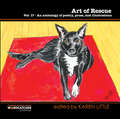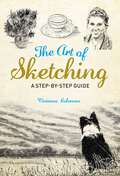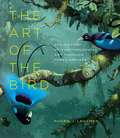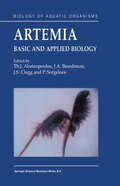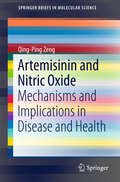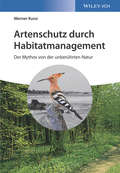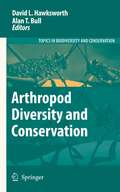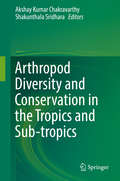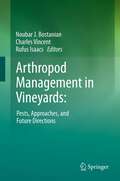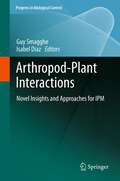- Table View
- List View
The Art of Raising a Puppy (Revised Edition)
by Monks of New SketeThe classic bestseller that established the Monks of New Skete as America's most trusted authorities on dog training, canine behavior, and the animal/human bond, updated to include the latest developments in canine health. In their two now-classic bestsellers, How to be Your Dog's Best Friend and The Art of Raising a Puppy, the Monks draw on their experience as long-time breeders of German shepherds and as trainers of dogs of all breeds to provide--brilliantly distilled--the indispensable information and advice that every dog owner needs. This new edition of The Art of Raising a Puppy features new photographs throughout, along with updated chapters on play, crating, adopting dogs from shelters and rescue organizations, raising dogs in an urban environment, and the latest developments in canine health and canine behavioral theory.
Art of Rescue: An anthology of poetry, prose and illustrations (Creative Portfolio Series #17)
by Various AuthorsEight writers weave words about their rescue pet, in poetry or prose. I hope in bringing together my drawings of adopted pets and their stories, we can demonstrate how wonderful shelter pets are. All author royalties from the sale of this book will be donated to the animal shelter EPAT.
The Art of Sketching: A Step by Step Guide
by Vivienne ColemanSketching is a wonderful pastime and a great way to build up your drawing skills. You can use it to record your experiences and subjects that interest you, just by jotting down an impression in your sketchbook. In this inspiring manual, artist Vivienne Coleman guides you through a variety of subjects in easy, confidence-building steps. She shows you how to do complete drawings in just a few minutes, so that you can make sketching part of your daily life. She also demonstrates how sketches can be developed into more detailed work. From pets and people to landscape and urban scenes, this book reveals how versatile and exciting sketching can be. It features:• ten-minute sketch ideas• essential drawing techniques• sketching at home and on the move• step-by-step instruction
The Art of the Bee: Shaping the Environment from Landscapes to Societies
by Robert E. PageThe impact of bees on our world is immeasurable. Bees are responsible for the evolution of the vast array of brightly colored flowers and for engineering the niches of multitudes of plants, animals, and microbes. They've painted our landscapes with flowers through their pollination activities, and they have evolved the most complex societies to aid their exploitation of the environment. The parallels between human and insect societies have been explored by countless sociobiologists. Traditional texts present stratified layers of knowledge where the reader excavates levels of biological organization, each building on the last. In this book, Robert E. Page, Jr., delves deep into the evolutionary history and the sociality of bees. He presents fundamental biology-not in layers, but wrapped around interesting themes and concepts, and in ways designed to explore and understand each concept. Page uses the social contract as a way to examine the complex social system of bee societies, a contract that has been written over millions of years of social evolution on the fabric of DNA. The book examines the coevolution of bees and flowering plants, bees as engineers of the environment, the evolution of sociality, the honey bee as a superorganism and how it evolves, and the mating behavior of the queen. The resulting book explores the ways human societies and bee colonies are similar-not from a common ancestry with shared genes for sociality, but from shared fundamentals of political philosophy.
The Art of the Bee: Shaping the Environment from Landscapes to Societies
by Robert E. PageThe impact of bees on our world is immeasurable. Bees are responsible for the evolution of the vast array of brightly colored flowers and for engineering the niches of multitudes of plants, animals, and microbes. They've painted our landscapes with flowers through their pollination activities, and they have evolved the most complex societies to aid their exploitation of the environment. The parallels between human and insect societies have been explored by countless sociobiologists. Traditional texts present stratified layers of knowledge where the reader excavates levels of biological organization, each building on the last. In this book, Robert E. Page, Jr., delves deep into the evolutionary history and the sociality of bees. He presents fundamental biology-not in layers, but wrapped around interesting themes and concepts, and in ways designed to explore and understand each concept. Page uses the social contract as a way to examine the complex social system of bee societies, a contract that has been written over millions of years of social evolution on the fabric of DNA. The book examines the coevolution of bees and flowering plants, bees as engineers of the environment, the evolution of sociality, the honey bee as a superorganism and how it evolves, and the mating behavior of the queen. The resulting book explores the ways human societies and bee colonies are similar-not from a common ancestry with shared genes for sociality, but from shared fundamentals of political philosophy.
The Art of the Bird: The History of Ornithological Art through Forty Artists
by Roger J. LedererThe human history of depicting birds dates to as many as 40,000 years ago, when Paleolithic artists took to cave walls to capture winged and other beasts. But the art form has reached its peak in the last four hundred years. In The Art of the Bird, devout birder and ornithologist Roger J. Lederer celebrates this heyday of avian illustration in forty artists’ profiles, beginning with the work of Flemish painter Frans Snyders in the early 1600s and continuing through to contemporary artists like Elizabeth Butterworth, famed for her portraits of macaws. Stretching its wings across time, taxa, geography, and artistic style—from the celebrated realism of American conservation icon John James Audubon, to Elizabeth Gould’s nineteenth-century renderings of museum specimens from the Himalayas, to Swedish artist and ornithologist Lars Jonsson’s ethereal watercolors—this book is feathered with art and artists as diverse and beautiful as their subjects. A soaring exploration of our fascination with the avian form, The Art of the Bird is a testament to the ways in which the intense observation inherent in both art and science reveals the mysteries of the natural world.
The Art of the Bird: The History of Ornithological Art through Forty Artists
by Roger J. LedererThe human history of depicting birds dates to as many as 40,000 years ago, when Paleolithic artists took to cave walls to capture winged and other beasts. But the art form has reached its peak in the last four hundred years. In The Art of the Bird, devout birder and ornithologist Roger J. Lederer celebrates this heyday of avian illustration in forty artists’ profiles, beginning with the work of Flemish painter Frans Snyders in the early 1600s and continuing through to contemporary artists like Elizabeth Butterworth, famed for her portraits of macaws. Stretching its wings across time, taxa, geography, and artistic style—from the celebrated realism of American conservation icon John James Audubon, to Elizabeth Gould’s nineteenth-century renderings of museum specimens from the Himalayas, to Swedish artist and ornithologist Lars Jonsson’s ethereal watercolors—this book is feathered with art and artists as diverse and beautiful as their subjects. A soaring exploration of our fascination with the avian form, The Art of the Bird is a testament to the ways in which the intense observation inherent in both art and science reveals the mysteries of the natural world.
Artemia: Basic and Applied Biology (Biology of Aquatic Organisms #1)
by Th. J. Abatzopoulos J. A. Beardmore J. S. Clegg P. SorgeloosThe objectives of this volume are to present an up-to-date (literature survey up to 2001) account of the biology of Artemia focusing particularly upon the major advances in knowledge and understanding achieved in the last fifteen or so years and emphasising the operational and functional linkage between the biological phenomena described and the ability of this unusual animal to thrive in extreme environments. Artemia is a genus of anostracan crustaceans, popularly known as brine shrimps. These animals are inhabitants of saline environments which are too extreme for the many species which readily predate them if opportunity offers. They are, thus, effectively inhabitants of extreme (hypersaline) habitats, but at the same time are able to tolerate physiologically large changes in salinity, ionic composition, temperature and oxygen tension. Brine shrimp are gener ally thought of as tropical and subtropical, but are also found in regions where temperatures are very low for substantial periods such as Tibet, Siberia and the Atacama desert. They have, thus, great powers of adaptation and are of interest for this capacity alone. The earliest scientific reference to brine shrimp is in 1756, when Schlosser reported their existence in the saltpans of Lymington, England. These saltpans no longer exist and brine shrimp are not found in Britain today. Later, Linnaeus named the brine shrimp Cancer salinus and later still, Leach used the name Artemia salina. The strong effect which the salinity of the medium exerts on the morphological development of Artemia is now widely recognised.
Artemisinin and Nitric Oxide: Mechanisms and Implications in Disease and Health (SpringerBriefs in Molecular Science)
by Qing-Ping ZengThis book discusses both the beneficial and harmful aspects of NO in biology and medicine, and also introduces the emerging discovery of artemisinin in antitumor, antibacterial infection, anti-inflammation, and antiaging contexts. In 1992 nitric oxide (NO) was voted “Molecule of the Year” by Science magazine, and the discovery of its physiological roles has led to Nobel Prize-winning work in neuroscience, physiology and immunology. The book explains why we should maintain a steady-state NO level that is derived from neuronal or epithelial NO synthase, and avoid the extremely high NO level resulting from inducible NO synthase. The book offers a valuable resource for medical chemists, clinicians, biologists and all those interested in health and disease.
Artenschutz durch Habitatmanagement: Der Mythos von der unberührten Natur
by Werner KunzIn der Praxis des Naturschutzes findet gerade ein Paradigmenwechsel statt. Um die Artenvielfalt zu erhalten, reicht es oft nicht aus, einen Lebensraum lediglich vor auβeren Einflussen zu schutzen und dann sich selbst zu uberlassen. Die aktive Gestaltung von Lebensraumen z. B. durch Schaffung von Brachflachen, Steilufern oder Gerollhaufen schafft okologische Nischen fur Tier- und Pflanzenarten, die sonst aus Mitteleuropa verschwinden wurden. Dafur sind Tagebauabgrabungen und Truppenubungsplatze bekannte Beispiele. Auch die Heidegebiete und Trockenrasen sind vom Menschen gestaltete und unterhaltene Lebensraume, in denen zahlreiche seltene Pflanzen und Insekten zu finden sind. Der Autor belegt anhand zahlreicher Beispiele von seltenen Vogel- und Insektenarten, dass die Erhaltung in ihrer Existenz bedrohter Arten in Mitteleuropa nicht einfach mit dem Schutz der Natur gleichgesetzt werden kann. Er fordert stattdessen, dass die unter Schutz gestellten Gebiete vor der Natur geschutzt werden. Dazu ist ein standiges Biotop-Management mit technischem Gerat erforderlich, das auf die Habitat-Bedurfnisse besonders gefahrdeter Arten eingerichtet ist und ihnen die erforderlichen Nahrungs- und Fortpflanzungsmoglichkeiten gibt. Kunz erlautert, wie durch eine intelligente Umgestaltung unserer Kulturlandschaft neue Lebensraume fur zahlreiche Arten auf der "Roten Liste" geschaffen werden und so die historische Artenvielfalt der Agrar- und Weideflachen Mitteleuropas auch im Zeitalter der technisierten Landwirtschaft erhalten werden kann. Als wichtiger Beitrag zur aktuellen Debatte uber die Zukunft des Natur- und Artenschutzes sollte dieses Buch zur Pflichtlekture fur jeden Naturschutzer gehoren.
Artenschutz durch Habitatmanagement: Der Mythos von der unberührten Natur
by Werner KunzIn der Praxis des Naturschutzes findet gerade ein Paradigmenwechsel statt. Um die Artenvielfalt zu erhalten, reicht es oft nicht aus, einen Lebensraum lediglich vor auβeren Einflussen zu schutzen und dann sich selbst zu uberlassen. Die aktive Gestaltung von Lebensraumen z. B. durch Schaffung von Brachflachen, Steilufern oder Gerollhaufen schafft okologische Nischen fur Tier- und Pflanzenarten, die sonst aus Mitteleuropa verschwinden wurden. Dafur sind Tagebauabgrabungen und Truppenubungsplatze bekannte Beispiele. Auch die Heidegebiete und Trockenrasen sind vom Menschen gestaltete und unterhaltene Lebensraume, in denen zahlreiche seltene Pflanzen und Insekten zu finden sind. Der Autor belegt anhand zahlreicher Beispiele von seltenen Vogel- und Insektenarten, dass die Erhaltung in ihrer Existenz bedrohter Arten in Mitteleuropa nicht einfach mit dem Schutz der Natur gleichgesetzt werden kann. Er fordert stattdessen, dass die unter Schutz gestellten Gebiete vor der Natur geschutzt werden. Dazu ist ein standiges Biotop-Management mit technischem Gerat erforderlich, das auf die Habitat-Bedurfnisse besonders gefahrdeter Arten eingerichtet ist und ihnen die erforderlichen Nahrungs- und Fortpflanzungsmoglichkeiten gibt. Kunz erlautert, wie durch eine intelligente Umgestaltung unserer Kulturlandschaft neue Lebensraume fur zahlreiche Arten auf der "Roten Liste" geschaffen werden und so die historische Artenvielfalt der Agrar- und Weideflachen Mitteleuropas auch im Zeitalter der technisierten Landwirtschaft erhalten werden kann. Als wichtiger Beitrag zur aktuellen Debatte uber die Zukunft des Natur- und Artenschutzes sollte dieses Buch zur Pflichtlekture fur jeden Naturschutzer gehoren.
Arterial Chemoreception
by Carlos Eyzaguirre Sal J. Fidone Robert S. Fitzgerald Sukhamay Lahiri Donald M. McDonaldThis book entitled Arterial Chemoreception is an edited compilation of the oral communications and posters presented at the IXth International Sym posium on Arterial Chemoreceptors held in Park City, Utah, from August 29th to September 3rd, 1988. The Symposium also saw the formal inau guration and first meeting of the International Society for Arterial Che moreception (ISAC). In all there were 87 presentations by 108 scientists from 18 countries. Authors making multiple presentations at Park City combined their results into single, longer papers for this volume. As a result this vol~me offers the reader 63 contributions of state-of-the-art research in this important and exciting field. Inasmuch as oxygen is the substrate sine qua non for the survival of all higher organisms, it is quite understandable that considerable interest sur rounds investigations into mechanisms responsible for detecting dwindling oxygen supplies in the organism. This interest has intensified as the newer techniques of cell, sub-cell, and molecular biology have become available. As detectors of insufficient oxygen in the arterial blood the arterial che moreceptors (carotid and aortic bodies) initiate many cardiopulmonary reflexes geared toward maintaining constant the delivery of oxygen to the tissues. These chemoreceptors, which also trigger secretions from the ad renal glands, are located near the carotid sinus and in the arch of the aorta.
Arterial Chemoreceptors: Cell to System (Advances in Experimental Medicine and Biology #360)
by David J. Paterson Daniel S. McQueen PhilipNolan Ronan G. O’ReganThe International Society for Arterial Chemoreception (ISAC) was founded in August 1988 during the 9th International Symposium on Arterial Chemoreception which was held at Park City, Utah, USA. ISAC was established with the aim of providing a framework to support the increasing number of investigators from a wide variety of disciplines (anatomists, pathologists, respiratory physiologists and clinicians, high altitude physiologists, biochemists, biophysicists, physiologists and pharmacologists) who share a common interest in arterial chemoreception. ISAC took over the co-ordination of the international chemoreceptor meetings, with the membership deciding the venue for forthcoming meetings. During the Park City symposium Dublin was selected to host the 1993 meeting, under the Presidency of Professor Ronan O'Regan. The 12th International Meeting on Arterial Chemoreception, which was held in Dublin in August 1993, was acclaimed as a great success by all those present. The delegates not only shared in a wide-ranging feast of chemoreceptor based science, they had plenty of opportunity during the meeting for renewing acquaintances and establishing new friendships. The location for the meeting at University College Dublin's modem Belfield campus helped to promote such interaction, and the social programme was outstanding.
Arthropod Biology and Evolution: Molecules, Development, Morphology
by Alessandro Minelli, Geoffrey Boxshall and Giuseppe FuscoMore than two thirds of all living organisms described to date belong to the phylum Arthropoda. But their diversity, as measured in terms of species number, is also accompanied by an amazing disparity in terms of body form, developmental processes, and adaptations to every inhabitable place on Earth, from the deepest marine abysses to the earth surface and the air. The Arthropoda also include one of the most fashionable and extensively studied of all model organisms, the fruit-fly, whose name is not only linked forever to Mendelian and population genetics, but has more recently come back to centre stage as one of the most important and more extensively investigated models in developmental genetics. This approach has completely changed our appreciation of some of the most characteristic traits of arthropods as are the origin and evolution of segments, their regional and individual specialization, and the origin and evolution of the appendages. At approximately the same time as developmental genetics was eventually turning into the major agent in the birth of evolutionary developmental biology (evo-devo), molecular phylogenetics was challenging the traditional views on arthropod phylogeny, including the relationships among the four major groups: insects, crustaceans, myriapods, and chelicerates. In the meantime, palaeontology was revealing an amazing number of extinct forms that on the one side have contributed to a radical revisitation of arthropod phylogeny, but on the other have provided evidence of a previously unexpected disparity of arthropod and arthropod-like forms that often challenge a clear-cut delimitation of the phylum.
Arthropod Borne Diseases
by Carlos Brisola MarcondesArthropod borne diseases cause enormous morbidity and mortality in most countries, mostly in those situated in tropical areas, but also in temperate regions. This book provides organized information on all arthropod related diseases, to prevent suffering and deaths, for medical students and professionals. Since arthropod borne diseases are present in many regions of the world and can even surprise professionals and lays in non-endemic regions, like malaria in UK and Canada, the author and its many expert collaborators are sure that it will be essential in all hospitals, clinics and medical libraries around the world. As arthropod borne diseases of domesticated animals are very numerous and in some cases related to human diseases, they are also included in the book.
Arthropod-borne Infectious Diseases of the Dog and Cat
by Michael J. DayThis book is an invaluable resource for information on the clinical presentation, pathogenesis, diagnosis and treatment of major arthropod-transmitted diseases of dogs and cats. Illustrated in colour throughout, the book incorporates photographs of clinical cases, haematology, cytology and gross and microscopic pathology, which help understand the diagnosis and treatment of these diseases. The book goes beyond just covering the diseases themselves and also provides information on the arthropods that transmit them. With the effects of climate change and increasing international pet travel, this book will be a valuable addition to every small animal practitioner's library.
Arthropod-borne Infectious Diseases of the Dog and Cat
by Michael J. DayThis book is an invaluable resource for information on the clinical presentation, pathogenesis, diagnosis and treatment of major arthropod-transmitted diseases of dogs and cats. Illustrated in colour throughout, the book incorporates photographs of clinical cases, haematology, cytology and gross and microscopic pathology, which help understand the diagnosis and treatment of these diseases. The book goes beyond just covering the diseases themselves and also provides information on the arthropods that transmit them. With the effects of climate change and increasing international pet travel, this book will be a valuable addition to every small animal practitioner's library.
Arthropod Diversity and Conservation (Topics in Biodiversity and Conservation #1)
by David L. Hawksworth Alan T. BullThis collection of more than 30 peer-reviewed papers focuses on the diversity and conservation of arthropods, whose species inhabit virtually every recess and plane – and feature in virtually every food web – on the planet. Highlighting issues ranging from large-scale disturbance to local management, from spatial heterogeneity to temporal patterns, these papers reflect exciting new research – and take the reader to some of the most biodiverse corners of the planet.
Arthropod Diversity and Conservation in the Tropics and Sub-tropics
by Akshay Kumar Chakravarthy Shakunthala SridharaArthropods are invertebrates that constitute over 90% of the animal kingdom, and their bio-ecology is closely linked with global functioning and survival.Arthropods play an important role in maintaining the health of ecosystems, provide livelihoods and nutrition to human communities, and are important indicators of environmental change. Yet the population trends of several arthropods species show them to be in decline. Arthropods constitute a dominant group with 1.2 million species influencing earth’s biodiversity. Among arthropods, insects are predominant, with ca. 1 million species and having evolved some 350 million years ago. Arthropods are closely associated with living and non-living entities alike, making the ecosystem services they provide crucially important. In order to be effective, plans for the conservation of arthropods and ecosystems should include a mixture of strategies like protecting key habitats and genomic studies to formulate relevant policies for in situ and ex situ conservation.This two-volume book focuses on capturing the essentials of arthropod inventories, biology, and conservation.Further, it seeks to identify the mechanisms by which arthropod populations can be sustained in terrestrial and aquatic ecosystems, and by means of which certain problematic species be managed without producing harmful environmental side-effects.This edited compilation includes chapters contributed by over 80 biologists on a wide range of topics embracing the diversity, distribution, utility and conservation of arthropods and select groups of insect taxa. More importantly, it describes in detail the mechanisms of sustaining arthropod ecosystems, services and populations. It addresses the contribution of modern biological tools such as molecular and genetic techniques regulating gene expression, as well as conventional, indigenous practices in arthropod conservation. The contributors reiterate the importance of documenting and understanding the biology of arthropods from a holistic perspective before addressing conservation issues at large. This book offers a valuable resource for all zoologists, entomologists, ecologists, conservation biologists, policy makers, teachers and students interested in the conservation of biological resources.
Arthropod Management and Landscape Considerations in Large-Scale Agroecosystems
by Matthew O'Neal Steven E. Naranjo Ian MacRae Kristopher L Giles Tom Royer Peter C Ellsworth Kristen Baum Mahendra Bhandari Haley Butler Hannalene Du Plessis Norman C. Elliott Sarah Elzay Isaac L. Esquivel Ashleigh M. Faris Aaron J. Gassmann Maura Hall Louis S. Hesler Anders S. Huseth William D. Hutchison Robert L. Meagher Jr Lance J. Meinke Shannon L. Osborne Pankaj Pal Katherine A. Parys Dominic Reisig Nina Rudin Thomas W. Sappington Gregory A. Sword Ashley E. Tessnow Paul A. Umina Johnnie Van BergFor large-scale agroecosystems, patterns of pest population increases (graded increases or abrupt outbreaks) and declines (graded suppression or abrupt crashes) vary considerably and are influenced by factors within crop fields and across broader landscape scales. Better understanding of pest population dynamics and the implications of spatial interactions on the function and development of pest management approaches are the main themes of this important book. The book builds from a 60+ year history of field-based pest management by focusing on the drivers of pest management in large-scale agroecosystems and the landscape-scale processes that affect these drivers and contribute to variation in pest outbreaks and suppression. These drivers include abiotic and biotic influences such as weather, spatial composition and arrangement of landscape elements, and widely applied managed inputs such as planting and crop rotation schedules, crop varietal selection, and land and soil conservation efforts. The book introduces general concepts, opportunities, and challenges of arthropod management in large-scale agroecosystems. Case studies from major field crop-based agroecosystems are used to present research approaches and improve understanding and management of pest and beneficial insects in large-scale agroecosystems. Specific research findings are provided on multi-trophic interactions within the system as influenced by climate, landscape, and other ecological, agricultural, and social/economic components of the agroecosystem. The book concludes with a synthesis of these concepts and prospectus for future research and developments in arthropod management in large-scale, plant-based agroecosystems. The book is essential reading for researchers in applied entomology and ecology and for pest management practitioners.
Arthropod Management in Vineyards: Pests, Approaches, and Future Directions
by Noubar J. Bostanian, Charles Vincent and Rufus IsaacsProvides a state-of-the-science overview of arthropods affecting grape production around the world. Vineyard pest management is a dynamic and evolving field, and the contributed chapters provide insights into arthropods that limit this important crop and its products. Written by international experts from the major grape-growing regions, it provides a global overview of arthropods affecting vines and the novel strategies being used to prevent economic losses, including invasive pests affecting viticulture. The book contains reviews of the theoretical basis of integrated pest management, multiple chapters on biological control, current status of chemical control, as well as in-depth and well-illustrated reviews of the major arthropod pests affecting grape production and how they are being managed worldwide. This text will serve as a primary resource for applied entomologists, students, growers, and consultants with interests at the intersection of viticulture and applied entomology.
Arthropod-Plant Interactions: Novel Insights and Approaches for IPM (Progress in Biological Control #14)
by Guy Smagghe and Isabel DiazThe book consists of multiple chapters by leading experts on the different aspects in the unique relationship between arthropods and plants, the underlying mechanisms, realized successes and failures of interactions and application for IPM, and future lines of research and perspectives. Interesting is the availability of the current genomes of different insects, mites and nematodes and different important plants and agricultural crops to bring better insights in the cross talk mechanisms and interacting players. This book will be the first one that integrates all this fascinating and newest (from the last 5 years) information from different leading research laboratories in the world and with perspectives from academia, government and industry.
Arthropod Relationships (The Systematics Association Special Volume Series #55)
by Richard A. Fortey Richard H. ThomasThe arthropods contain more species than any other animal group, but the evolutionary pathways which led to their current diversity are still an issue of controversy. Arthropod Relationships provides an overview of our current understanding, responding to the new data arising from sequencing DNA, the discovery of new Cambrian fossils as direct evidence of early arthropod history, and developmental genetics. These new areas of research have stimulated a reconsideration of classical morphology and embryology. Arthropod Relationships is the first synthesis of the current debate to emerge: not since the volume edited by Gupta was published in 1979 has the arthropod phylogeny debate been, considered in this depth and breadth. Leaders in the various branches of arthropod biology have contributed to this volume. Chapters focus progressively from the general issues to the specific problems involving particular groups, and thence to a consideration of embryology and genetics. This wide range of disciplines is drawn on to approach an understanding of arthropod relationships, and to provide the most timely account of arthropod phylogeny. This book should be read by evolutionary biologists, palaeontologists, developmental geneticists and invertebrate zoologists. It will have a special interest for post-graduate students working in these fields.
Arthropods as Vectors of Emerging Diseases (Parasitology Research Monographs #3)
by Heinz MehlhornGlobal warming and globalization are the buzzwords of our time. They have nearly reached a religious status and those who deny their existence are considered modern heretics. Nevertheless, the earth has become an overcrowded village, traversable within a single day. Thus it is hardly surprising that besides persons and goods also agents of disease are easily transported daily from one end of the world to the other, threatening the health and lives of billions of humans and their animals. Agents of diseases (prions, viruses, bacteria, fungi and parasites) are not only transmitted by body contact or direct exchange of bodily fluids, but also by means of vectors which belong to the groups of licking or blood-sucking arthropods (mites, ticks, insects) that live close to humans and their houses. Without a doubt the recently accelerating globalization supports the import of agents of disease into countries where they never had been or where they had long since been eradicated, leading to a false sense of living on a “safe island.” These newly imported or reintroduced diseases – called “emerging diseases” – may lead to severe outbreaks in cases where the countries are not prepared to combat them, or in cases where viruses are introduced that cannot be controlled by medications or vaccines. Arthropods are well known vectors for the spread of diseases. Thus their invasion from foreign countries and their spreading close to human dwellings must be blocked everywhere (in donor and receptor countries) using safe and effective measures. This book presents reviews on examples of such arthropod-borne emerging diseases that lurk on the fringes of our crowded megacities. The following topics show that there is an ongoing invasion of potential vectors and that control measures must be used now in order to avoid disastrous outbreaks of mass diseases.
Arthropods of Mediterranean-Type Ecosystems (Adaptations of Desert Organisms)
by George P. StamouG.P. Stamou describes the adaptive strategies that allow arthropods to cope with the severity of Mediterranean environments. After an introduction to the structure and function of Mediterranean-type ecosystems, ecophysiological adaptations to water stress and varying temperature are considered. Further, activity patterns and life cycle tactics are discussed in relation to the peculiarity of Mediterranean environments. Phenological patterns and population dynamics as well as community structures are also presented. The volume ends with a synthesis of life history tactics.

